Physiological Principles for Health and Social Care - Report Analysis
VerifiedAdded on 2021/01/03
|18
|5587
|308
Report
AI Summary
This report delves into the physiological principles essential for health and social care. It begins with an introduction to the human body's complex structure, emphasizing the interplay of various organ systems, cells, and tissues, with a focus on anatomy and physiology. The report covers the anatomical features of the human body, detailing the nervous, respiratory, cardiovascular, and musculoskeletal systems and how they interact. It examines how these systems respond to regular activities, such as studying for long hours, and explains the body's responses in terms of physiology, cellular, and tissue structures. Furthermore, the report discusses how the body coordinates its internal activities through homeostasis, with a focus on the roles of the endocrine and nervous systems. It also addresses how routine measures are recorded and used in health and social care, providing information about body functioning that informs care planning, and how age and common disorders impact the body's structure and function.
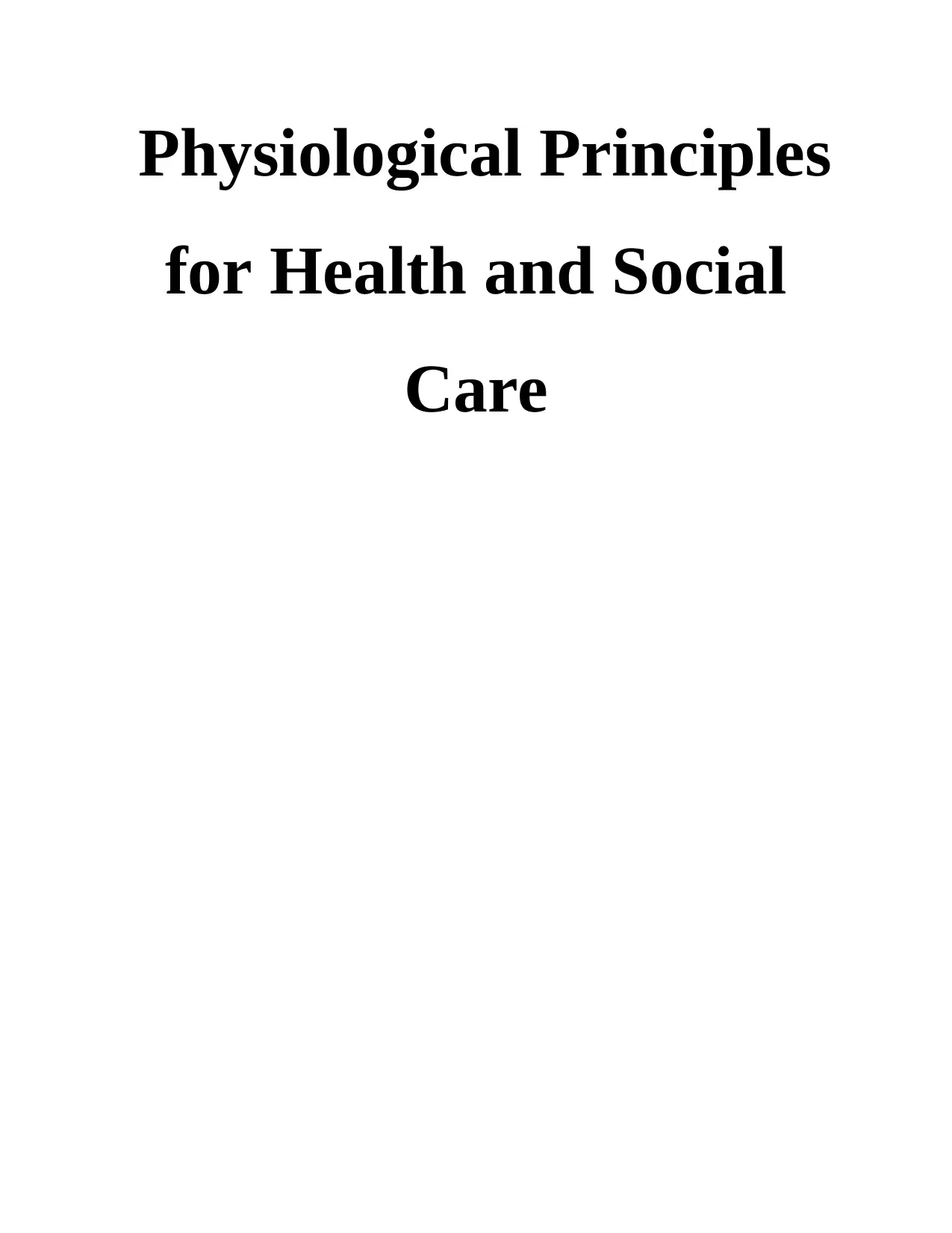
Physiological Principles
for Health and Social
Care
for Health and Social
Care
Paraphrase This Document
Need a fresh take? Get an instant paraphrase of this document with our AI Paraphraser
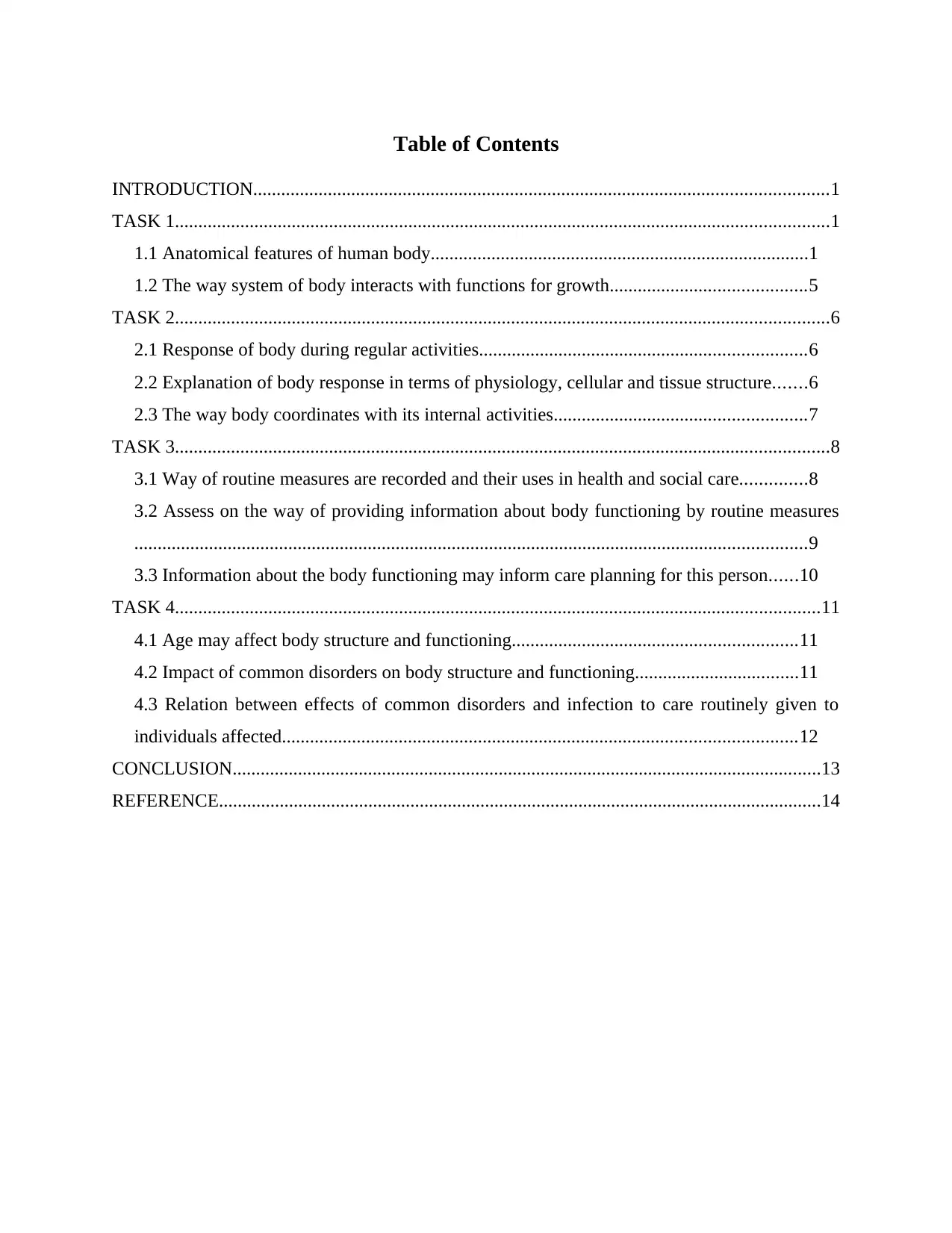
Table of Contents
INTRODUCTION...........................................................................................................................1
TASK 1............................................................................................................................................1
1.1 Anatomical features of human body.................................................................................1
1.2 The way system of body interacts with functions for growth..........................................5
TASK 2............................................................................................................................................6
2.1 Response of body during regular activities......................................................................6
2.2 Explanation of body response in terms of physiology, cellular and tissue structure.......6
2.3 The way body coordinates with its internal activities......................................................7
TASK 3............................................................................................................................................8
3.1 Way of routine measures are recorded and their uses in health and social care..............8
3.2 Assess on the way of providing information about body functioning by routine measures
................................................................................................................................................9
3.3 Information about the body functioning may inform care planning for this person......10
TASK 4..........................................................................................................................................11
4.1 Age may affect body structure and functioning.............................................................11
4.2 Impact of common disorders on body structure and functioning...................................11
4.3 Relation between effects of common disorders and infection to care routinely given to
individuals affected..............................................................................................................12
CONCLUSION..............................................................................................................................13
REFERENCE.................................................................................................................................14
INTRODUCTION...........................................................................................................................1
TASK 1............................................................................................................................................1
1.1 Anatomical features of human body.................................................................................1
1.2 The way system of body interacts with functions for growth..........................................5
TASK 2............................................................................................................................................6
2.1 Response of body during regular activities......................................................................6
2.2 Explanation of body response in terms of physiology, cellular and tissue structure.......6
2.3 The way body coordinates with its internal activities......................................................7
TASK 3............................................................................................................................................8
3.1 Way of routine measures are recorded and their uses in health and social care..............8
3.2 Assess on the way of providing information about body functioning by routine measures
................................................................................................................................................9
3.3 Information about the body functioning may inform care planning for this person......10
TASK 4..........................................................................................................................................11
4.1 Age may affect body structure and functioning.............................................................11
4.2 Impact of common disorders on body structure and functioning...................................11
4.3 Relation between effects of common disorders and infection to care routinely given to
individuals affected..............................................................................................................12
CONCLUSION..............................................................................................................................13
REFERENCE.................................................................................................................................14

⊘ This is a preview!⊘
Do you want full access?
Subscribe today to unlock all pages.

Trusted by 1+ million students worldwide
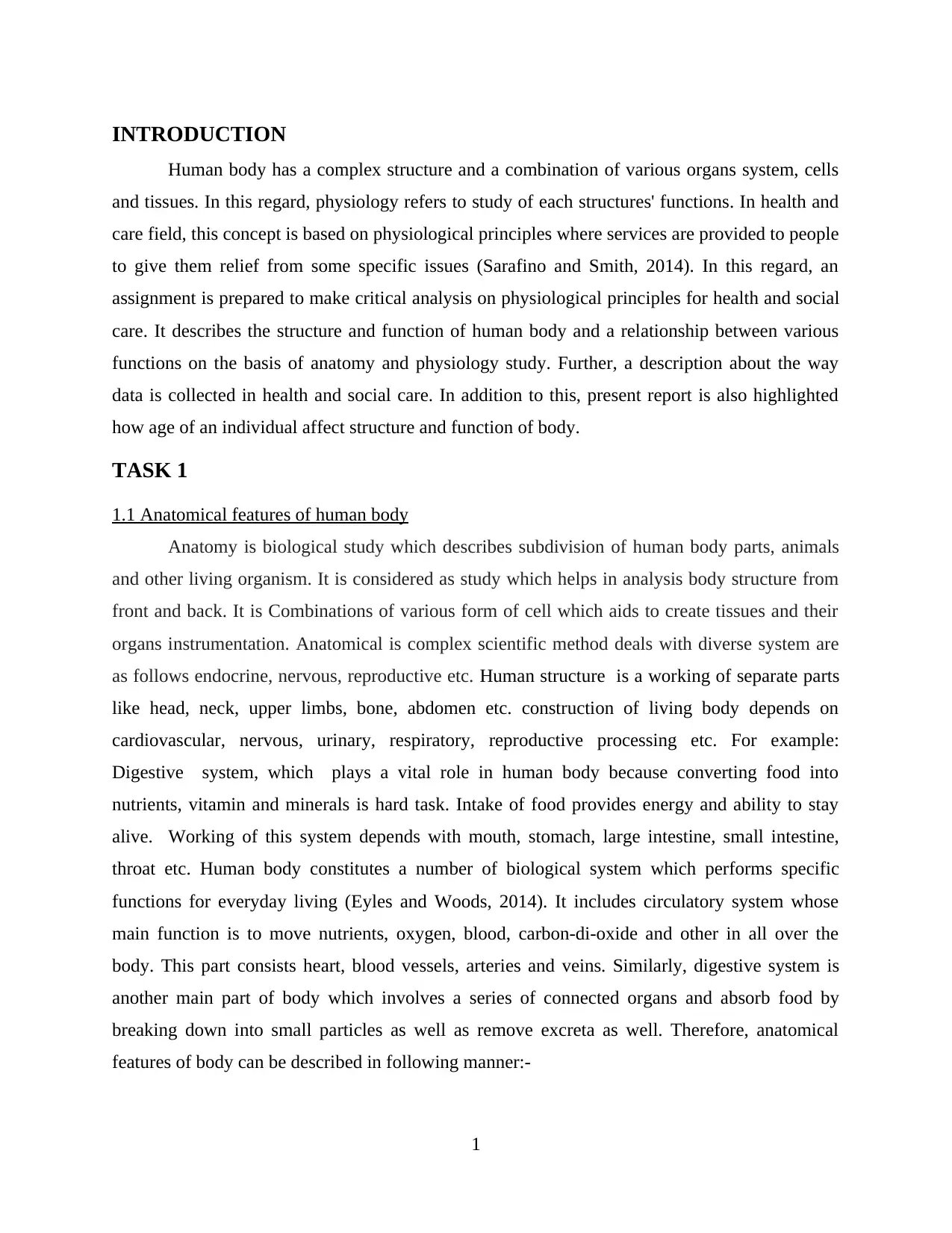
INTRODUCTION
Human body has a complex structure and a combination of various organs system, cells
and tissues. In this regard, physiology refers to study of each structures' functions. In health and
care field, this concept is based on physiological principles where services are provided to people
to give them relief from some specific issues (Sarafino and Smith, 2014). In this regard, an
assignment is prepared to make critical analysis on physiological principles for health and social
care. It describes the structure and function of human body and a relationship between various
functions on the basis of anatomy and physiology study. Further, a description about the way
data is collected in health and social care. In addition to this, present report is also highlighted
how age of an individual affect structure and function of body.
TASK 1
1.1 Anatomical features of human body
Anatomy is biological study which describes subdivision of human body parts, animals
and other living organism. It is considered as study which helps in analysis body structure from
front and back. It is Combinations of various form of cell which aids to create tissues and their
organs instrumentation. Anatomical is complex scientific method deals with diverse system are
as follows endocrine, nervous, reproductive etc. Human structure is a working of separate parts
like head, neck, upper limbs, bone, abdomen etc. construction of living body depends on
cardiovascular, nervous, urinary, respiratory, reproductive processing etc. For example:
Digestive system, which plays a vital role in human body because converting food into
nutrients, vitamin and minerals is hard task. Intake of food provides energy and ability to stay
alive. Working of this system depends with mouth, stomach, large intestine, small intestine,
throat etc. Human body constitutes a number of biological system which performs specific
functions for everyday living (Eyles and Woods, 2014). It includes circulatory system whose
main function is to move nutrients, oxygen, blood, carbon-di-oxide and other in all over the
body. This part consists heart, blood vessels, arteries and veins. Similarly, digestive system is
another main part of body which involves a series of connected organs and absorb food by
breaking down into small particles as well as remove excreta as well. Therefore, anatomical
features of body can be described in following manner:-
1
Human body has a complex structure and a combination of various organs system, cells
and tissues. In this regard, physiology refers to study of each structures' functions. In health and
care field, this concept is based on physiological principles where services are provided to people
to give them relief from some specific issues (Sarafino and Smith, 2014). In this regard, an
assignment is prepared to make critical analysis on physiological principles for health and social
care. It describes the structure and function of human body and a relationship between various
functions on the basis of anatomy and physiology study. Further, a description about the way
data is collected in health and social care. In addition to this, present report is also highlighted
how age of an individual affect structure and function of body.
TASK 1
1.1 Anatomical features of human body
Anatomy is biological study which describes subdivision of human body parts, animals
and other living organism. It is considered as study which helps in analysis body structure from
front and back. It is Combinations of various form of cell which aids to create tissues and their
organs instrumentation. Anatomical is complex scientific method deals with diverse system are
as follows endocrine, nervous, reproductive etc. Human structure is a working of separate parts
like head, neck, upper limbs, bone, abdomen etc. construction of living body depends on
cardiovascular, nervous, urinary, respiratory, reproductive processing etc. For example:
Digestive system, which plays a vital role in human body because converting food into
nutrients, vitamin and minerals is hard task. Intake of food provides energy and ability to stay
alive. Working of this system depends with mouth, stomach, large intestine, small intestine,
throat etc. Human body constitutes a number of biological system which performs specific
functions for everyday living (Eyles and Woods, 2014). It includes circulatory system whose
main function is to move nutrients, oxygen, blood, carbon-di-oxide and other in all over the
body. This part consists heart, blood vessels, arteries and veins. Similarly, digestive system is
another main part of body which involves a series of connected organs and absorb food by
breaking down into small particles as well as remove excreta as well. Therefore, anatomical
features of body can be described in following manner:-
1
Paraphrase This Document
Need a fresh take? Get an instant paraphrase of this document with our AI Paraphraser
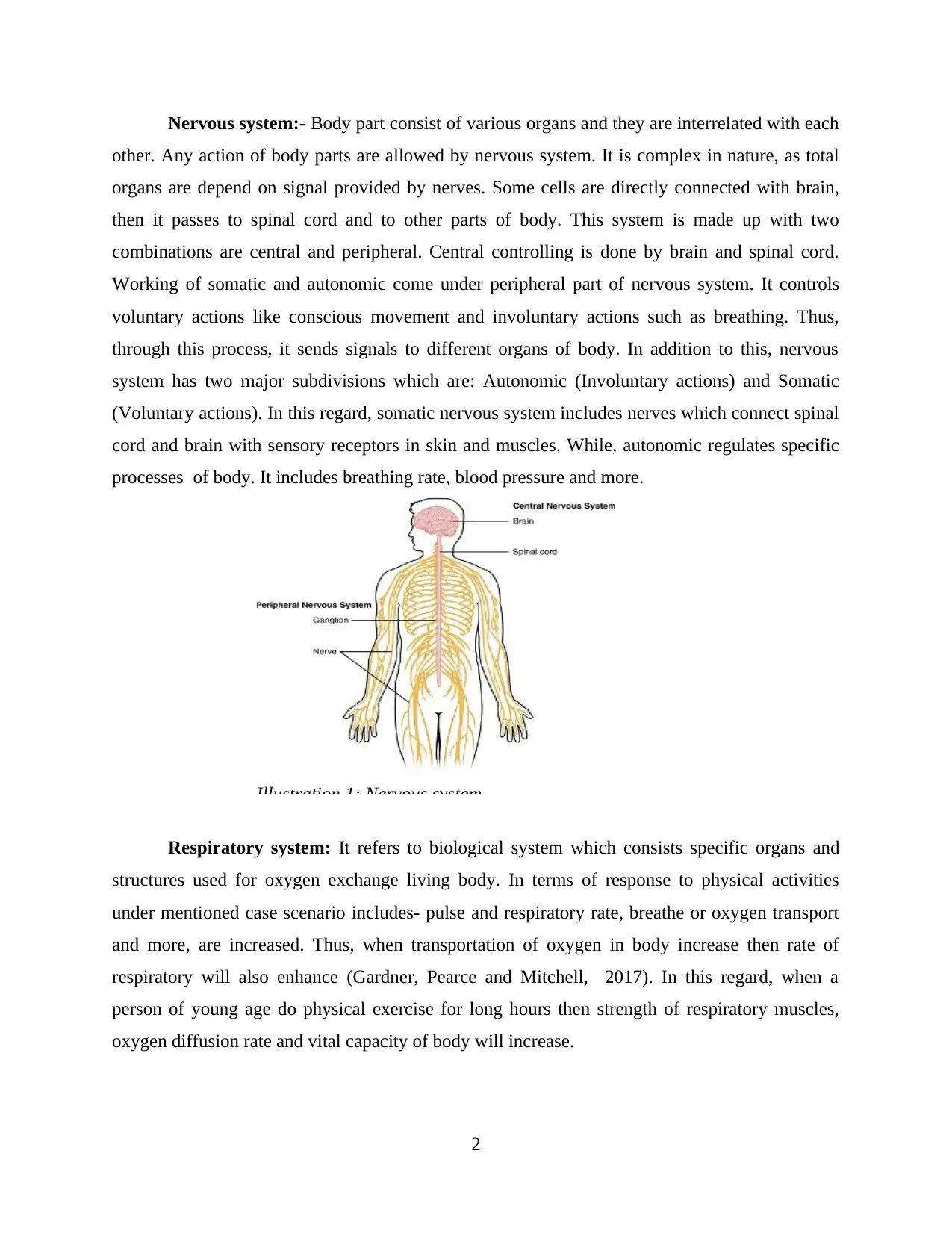
Nervous system:- Body part consist of various organs and they are interrelated with each
other. Any action of body parts are allowed by nervous system. It is complex in nature, as total
organs are depend on signal provided by nerves. Some cells are directly connected with brain,
then it passes to spinal cord and to other parts of body. This system is made up with two
combinations are central and peripheral. Central controlling is done by brain and spinal cord.
Working of somatic and autonomic come under peripheral part of nervous system. It controls
voluntary actions like conscious movement and involuntary actions such as breathing. Thus,
through this process, it sends signals to different organs of body. In addition to this, nervous
system has two major subdivisions which are: Autonomic (Involuntary actions) and Somatic
(Voluntary actions). In this regard, somatic nervous system includes nerves which connect spinal
cord and brain with sensory receptors in skin and muscles. While, autonomic regulates specific
processes of body. It includes breathing rate, blood pressure and more.
Respiratory system: It refers to biological system which consists specific organs and
structures used for oxygen exchange living body. In terms of response to physical activities
under mentioned case scenario includes- pulse and respiratory rate, breathe or oxygen transport
and more, are increased. Thus, when transportation of oxygen in body increase then rate of
respiratory will also enhance (Gardner, Pearce and Mitchell, 2017). In this regard, when a
person of young age do physical exercise for long hours then strength of respiratory muscles,
oxygen diffusion rate and vital capacity of body will increase.
2
Illustration 1: Nervous system
other. Any action of body parts are allowed by nervous system. It is complex in nature, as total
organs are depend on signal provided by nerves. Some cells are directly connected with brain,
then it passes to spinal cord and to other parts of body. This system is made up with two
combinations are central and peripheral. Central controlling is done by brain and spinal cord.
Working of somatic and autonomic come under peripheral part of nervous system. It controls
voluntary actions like conscious movement and involuntary actions such as breathing. Thus,
through this process, it sends signals to different organs of body. In addition to this, nervous
system has two major subdivisions which are: Autonomic (Involuntary actions) and Somatic
(Voluntary actions). In this regard, somatic nervous system includes nerves which connect spinal
cord and brain with sensory receptors in skin and muscles. While, autonomic regulates specific
processes of body. It includes breathing rate, blood pressure and more.
Respiratory system: It refers to biological system which consists specific organs and
structures used for oxygen exchange living body. In terms of response to physical activities
under mentioned case scenario includes- pulse and respiratory rate, breathe or oxygen transport
and more, are increased. Thus, when transportation of oxygen in body increase then rate of
respiratory will also enhance (Gardner, Pearce and Mitchell, 2017). In this regard, when a
person of young age do physical exercise for long hours then strength of respiratory muscles,
oxygen diffusion rate and vital capacity of body will increase.
2
Illustration 1: Nervous system
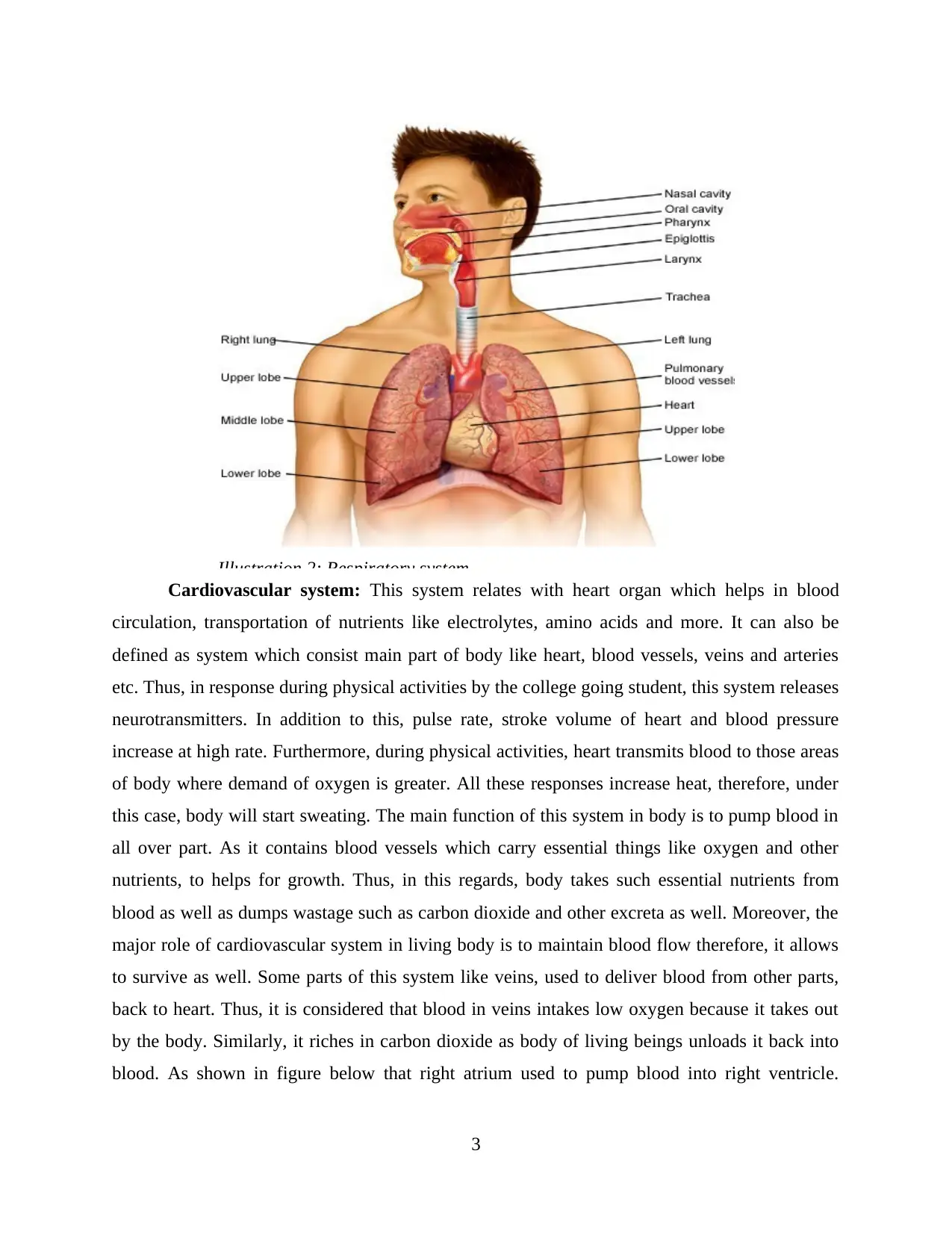
Cardiovascular system: This system relates with heart organ which helps in blood
circulation, transportation of nutrients like electrolytes, amino acids and more. It can also be
defined as system which consist main part of body like heart, blood vessels, veins and arteries
etc. Thus, in response during physical activities by the college going student, this system releases
neurotransmitters. In addition to this, pulse rate, stroke volume of heart and blood pressure
increase at high rate. Furthermore, during physical activities, heart transmits blood to those areas
of body where demand of oxygen is greater. All these responses increase heat, therefore, under
this case, body will start sweating. The main function of this system in body is to pump blood in
all over part. As it contains blood vessels which carry essential things like oxygen and other
nutrients, to helps for growth. Thus, in this regards, body takes such essential nutrients from
blood as well as dumps wastage such as carbon dioxide and other excreta as well. Moreover, the
major role of cardiovascular system in living body is to maintain blood flow therefore, it allows
to survive as well. Some parts of this system like veins, used to deliver blood from other parts,
back to heart. Thus, it is considered that blood in veins intakes low oxygen because it takes out
by the body. Similarly, it riches in carbon dioxide as body of living beings unloads it back into
blood. As shown in figure below that right atrium used to pump blood into right ventricle.
3
Illustration 2: Respiratory system
circulation, transportation of nutrients like electrolytes, amino acids and more. It can also be
defined as system which consist main part of body like heart, blood vessels, veins and arteries
etc. Thus, in response during physical activities by the college going student, this system releases
neurotransmitters. In addition to this, pulse rate, stroke volume of heart and blood pressure
increase at high rate. Furthermore, during physical activities, heart transmits blood to those areas
of body where demand of oxygen is greater. All these responses increase heat, therefore, under
this case, body will start sweating. The main function of this system in body is to pump blood in
all over part. As it contains blood vessels which carry essential things like oxygen and other
nutrients, to helps for growth. Thus, in this regards, body takes such essential nutrients from
blood as well as dumps wastage such as carbon dioxide and other excreta as well. Moreover, the
major role of cardiovascular system in living body is to maintain blood flow therefore, it allows
to survive as well. Some parts of this system like veins, used to deliver blood from other parts,
back to heart. Thus, it is considered that blood in veins intakes low oxygen because it takes out
by the body. Similarly, it riches in carbon dioxide as body of living beings unloads it back into
blood. As shown in figure below that right atrium used to pump blood into right ventricle.
3
Illustration 2: Respiratory system
⊘ This is a preview!⊘
Do you want full access?
Subscribe today to unlock all pages.

Trusted by 1+ million students worldwide
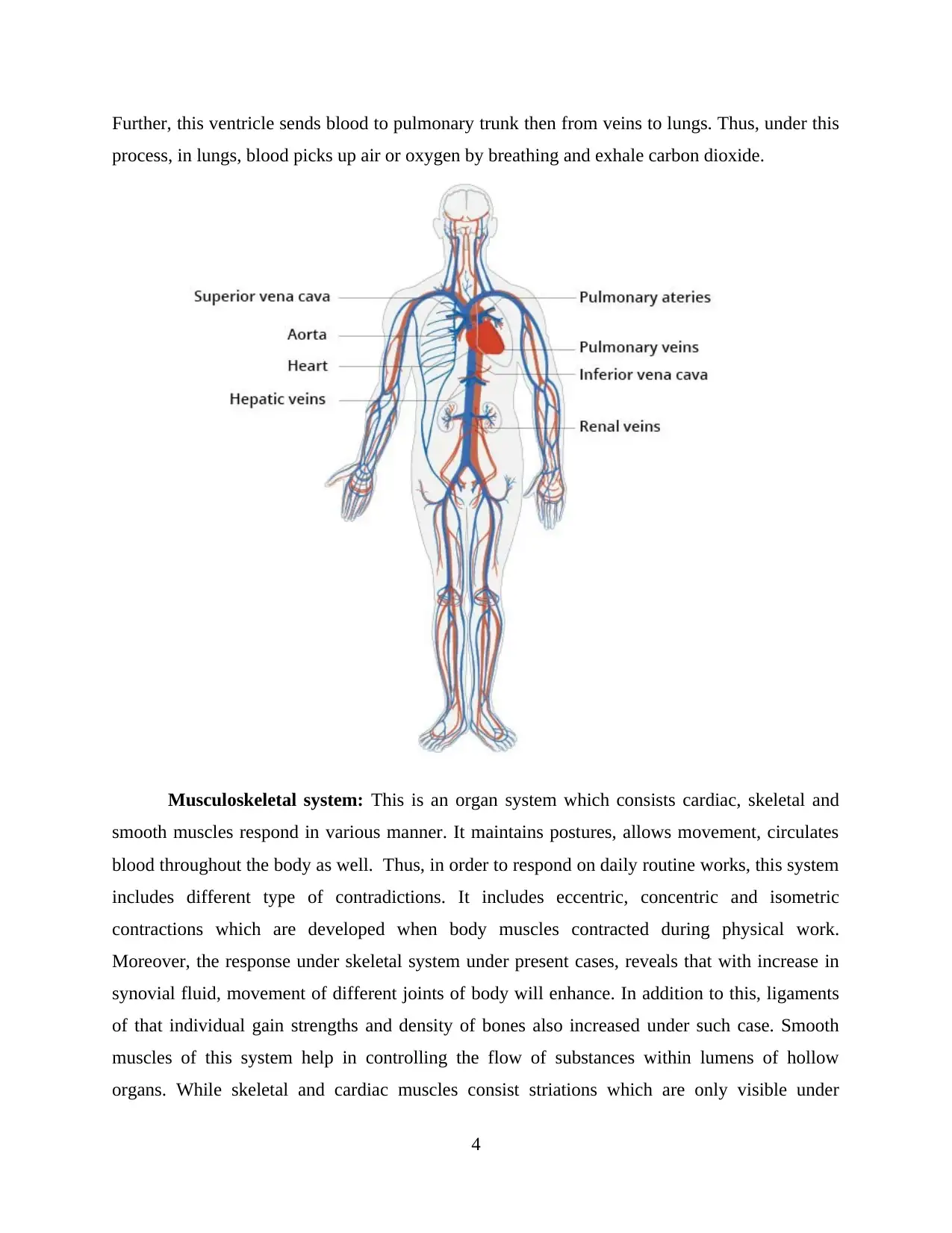
Further, this ventricle sends blood to pulmonary trunk then from veins to lungs. Thus, under this
process, in lungs, blood picks up air or oxygen by breathing and exhale carbon dioxide.
Musculoskeletal system: This is an organ system which consists cardiac, skeletal and
smooth muscles respond in various manner. It maintains postures, allows movement, circulates
blood throughout the body as well. Thus, in order to respond on daily routine works, this system
includes different type of contradictions. It includes eccentric, concentric and isometric
contractions which are developed when body muscles contracted during physical work.
Moreover, the response under skeletal system under present cases, reveals that with increase in
synovial fluid, movement of different joints of body will enhance. In addition to this, ligaments
of that individual gain strengths and density of bones also increased under such case. Smooth
muscles of this system help in controlling the flow of substances within lumens of hollow
organs. While skeletal and cardiac muscles consist striations which are only visible under
4
process, in lungs, blood picks up air or oxygen by breathing and exhale carbon dioxide.
Musculoskeletal system: This is an organ system which consists cardiac, skeletal and
smooth muscles respond in various manner. It maintains postures, allows movement, circulates
blood throughout the body as well. Thus, in order to respond on daily routine works, this system
includes different type of contradictions. It includes eccentric, concentric and isometric
contractions which are developed when body muscles contracted during physical work.
Moreover, the response under skeletal system under present cases, reveals that with increase in
synovial fluid, movement of different joints of body will enhance. In addition to this, ligaments
of that individual gain strengths and density of bones also increased under such case. Smooth
muscles of this system help in controlling the flow of substances within lumens of hollow
organs. While skeletal and cardiac muscles consist striations which are only visible under
4
Paraphrase This Document
Need a fresh take? Get an instant paraphrase of this document with our AI Paraphraser
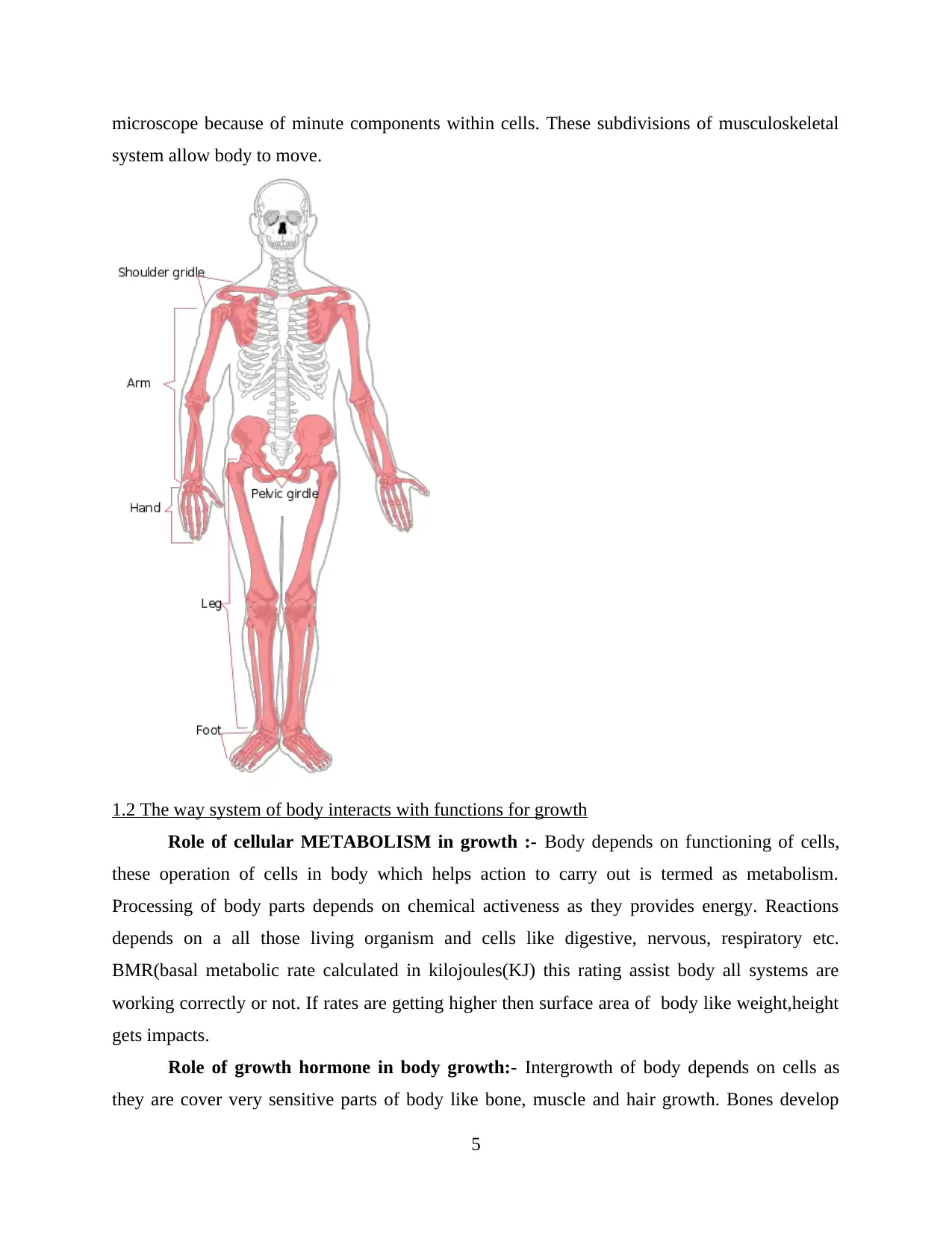
microscope because of minute components within cells. These subdivisions of musculoskeletal
system allow body to move.
1.2 The way system of body interacts with functions for growth
Role of cellular METABOLISM in growth :- Body depends on functioning of cells,
these operation of cells in body which helps action to carry out is termed as metabolism.
Processing of body parts depends on chemical activeness as they provides energy. Reactions
depends on a all those living organism and cells like digestive, nervous, respiratory etc.
BMR(basal metabolic rate calculated in kilojoules(KJ) this rating assist body all systems are
working correctly or not. If rates are getting higher then surface area of body like weight,height
gets impacts.
Role of growth hormone in body growth:- Intergrowth of body depends on cells as
they are cover very sensitive parts of body like bone, muscle and hair growth. Bones develop
5
system allow body to move.
1.2 The way system of body interacts with functions for growth
Role of cellular METABOLISM in growth :- Body depends on functioning of cells,
these operation of cells in body which helps action to carry out is termed as metabolism.
Processing of body parts depends on chemical activeness as they provides energy. Reactions
depends on a all those living organism and cells like digestive, nervous, respiratory etc.
BMR(basal metabolic rate calculated in kilojoules(KJ) this rating assist body all systems are
working correctly or not. If rates are getting higher then surface area of body like weight,height
gets impacts.
Role of growth hormone in body growth:- Intergrowth of body depends on cells as
they are cover very sensitive parts of body like bone, muscle and hair growth. Bones develop
5
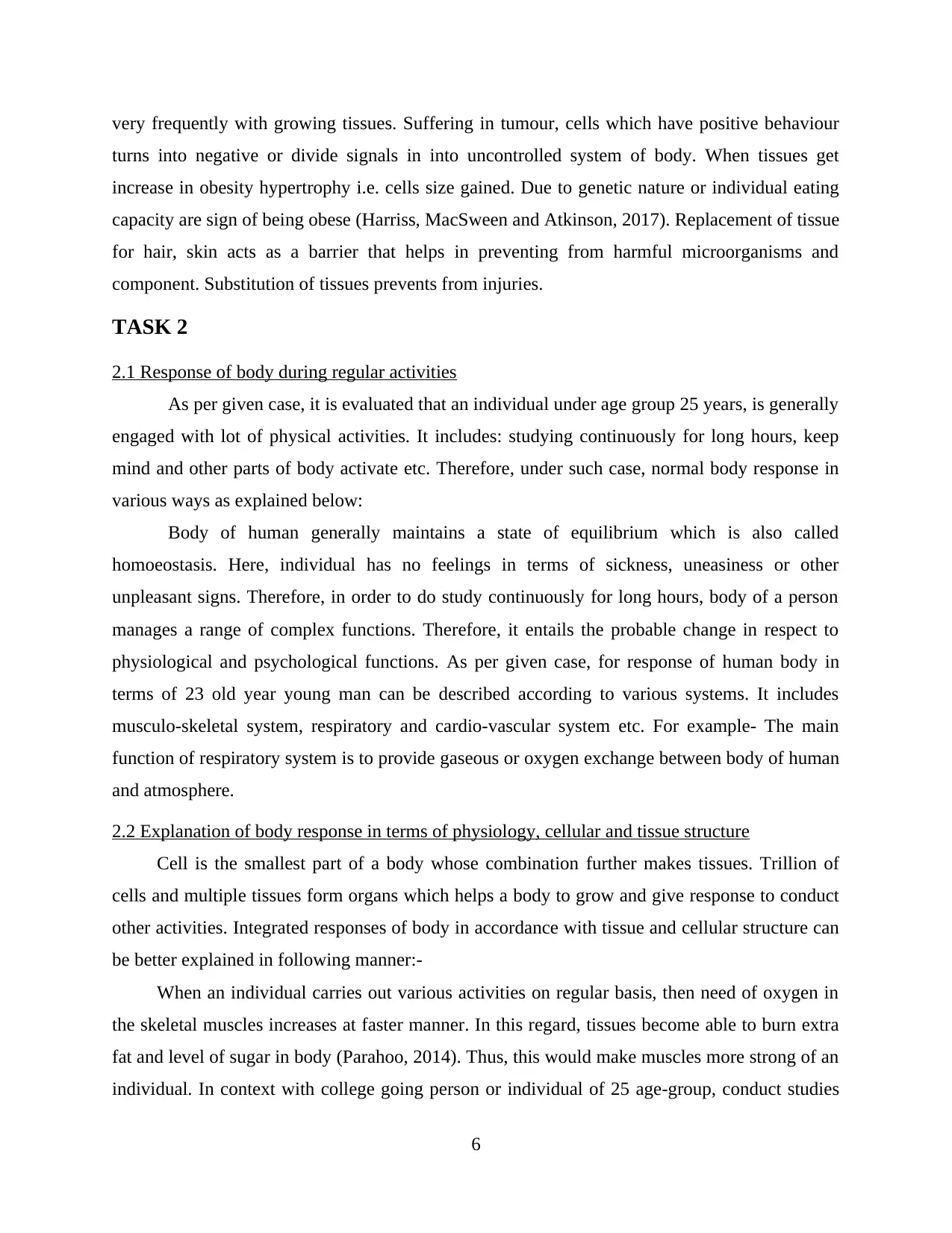
very frequently with growing tissues. Suffering in tumour, cells which have positive behaviour
turns into negative or divide signals in into uncontrolled system of body. When tissues get
increase in obesity hypertrophy i.e. cells size gained. Due to genetic nature or individual eating
capacity are sign of being obese (Harriss, MacSween and Atkinson, 2017). Replacement of tissue
for hair, skin acts as a barrier that helps in preventing from harmful microorganisms and
component. Substitution of tissues prevents from injuries.
TASK 2
2.1 Response of body during regular activities
As per given case, it is evaluated that an individual under age group 25 years, is generally
engaged with lot of physical activities. It includes: studying continuously for long hours, keep
mind and other parts of body activate etc. Therefore, under such case, normal body response in
various ways as explained below:
Body of human generally maintains a state of equilibrium which is also called
homoeostasis. Here, individual has no feelings in terms of sickness, uneasiness or other
unpleasant signs. Therefore, in order to do study continuously for long hours, body of a person
manages a range of complex functions. Therefore, it entails the probable change in respect to
physiological and psychological functions. As per given case, for response of human body in
terms of 23 old year young man can be described according to various systems. It includes
musculo-skeletal system, respiratory and cardio-vascular system etc. For example- The main
function of respiratory system is to provide gaseous or oxygen exchange between body of human
and atmosphere.
2.2 Explanation of body response in terms of physiology, cellular and tissue structure
Cell is the smallest part of a body whose combination further makes tissues. Trillion of
cells and multiple tissues form organs which helps a body to grow and give response to conduct
other activities. Integrated responses of body in accordance with tissue and cellular structure can
be better explained in following manner:-
When an individual carries out various activities on regular basis, then need of oxygen in
the skeletal muscles increases at faster manner. In this regard, tissues become able to burn extra
fat and level of sugar in body (Parahoo, 2014). Thus, this would make muscles more strong of an
individual. In context with college going person or individual of 25 age-group, conduct studies
6
turns into negative or divide signals in into uncontrolled system of body. When tissues get
increase in obesity hypertrophy i.e. cells size gained. Due to genetic nature or individual eating
capacity are sign of being obese (Harriss, MacSween and Atkinson, 2017). Replacement of tissue
for hair, skin acts as a barrier that helps in preventing from harmful microorganisms and
component. Substitution of tissues prevents from injuries.
TASK 2
2.1 Response of body during regular activities
As per given case, it is evaluated that an individual under age group 25 years, is generally
engaged with lot of physical activities. It includes: studying continuously for long hours, keep
mind and other parts of body activate etc. Therefore, under such case, normal body response in
various ways as explained below:
Body of human generally maintains a state of equilibrium which is also called
homoeostasis. Here, individual has no feelings in terms of sickness, uneasiness or other
unpleasant signs. Therefore, in order to do study continuously for long hours, body of a person
manages a range of complex functions. Therefore, it entails the probable change in respect to
physiological and psychological functions. As per given case, for response of human body in
terms of 23 old year young man can be described according to various systems. It includes
musculo-skeletal system, respiratory and cardio-vascular system etc. For example- The main
function of respiratory system is to provide gaseous or oxygen exchange between body of human
and atmosphere.
2.2 Explanation of body response in terms of physiology, cellular and tissue structure
Cell is the smallest part of a body whose combination further makes tissues. Trillion of
cells and multiple tissues form organs which helps a body to grow and give response to conduct
other activities. Integrated responses of body in accordance with tissue and cellular structure can
be better explained in following manner:-
When an individual carries out various activities on regular basis, then need of oxygen in
the skeletal muscles increases at faster manner. In this regard, tissues become able to burn extra
fat and level of sugar in body (Parahoo, 2014). Thus, this would make muscles more strong of an
individual. In context with college going person or individual of 25 age-group, conduct studies
6
⊘ This is a preview!⊘
Do you want full access?
Subscribe today to unlock all pages.

Trusted by 1+ million students worldwide
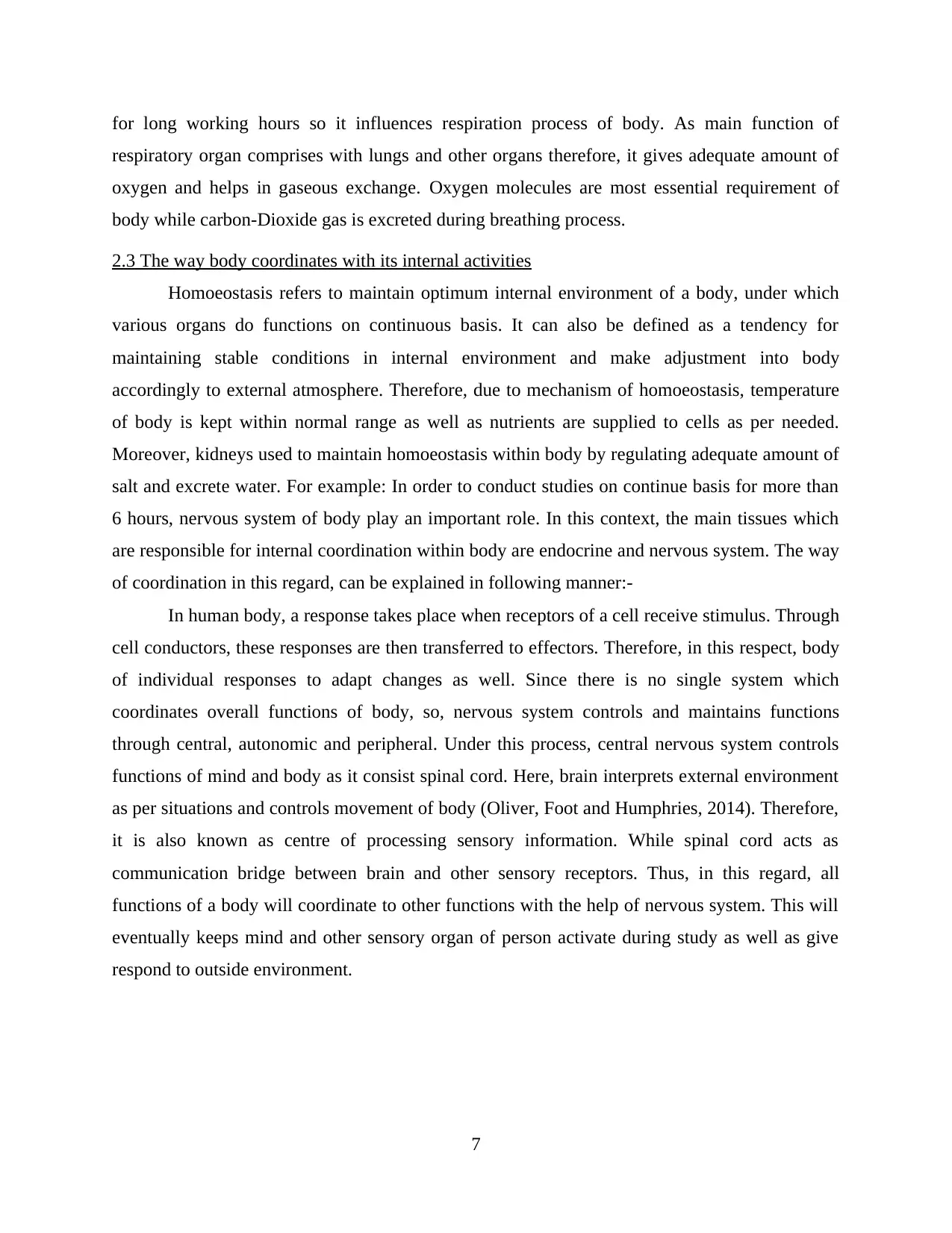
for long working hours so it influences respiration process of body. As main function of
respiratory organ comprises with lungs and other organs therefore, it gives adequate amount of
oxygen and helps in gaseous exchange. Oxygen molecules are most essential requirement of
body while carbon-Dioxide gas is excreted during breathing process.
2.3 The way body coordinates with its internal activities
Homoeostasis refers to maintain optimum internal environment of a body, under which
various organs do functions on continuous basis. It can also be defined as a tendency for
maintaining stable conditions in internal environment and make adjustment into body
accordingly to external atmosphere. Therefore, due to mechanism of homoeostasis, temperature
of body is kept within normal range as well as nutrients are supplied to cells as per needed.
Moreover, kidneys used to maintain homoeostasis within body by regulating adequate amount of
salt and excrete water. For example: In order to conduct studies on continue basis for more than
6 hours, nervous system of body play an important role. In this context, the main tissues which
are responsible for internal coordination within body are endocrine and nervous system. The way
of coordination in this regard, can be explained in following manner:-
In human body, a response takes place when receptors of a cell receive stimulus. Through
cell conductors, these responses are then transferred to effectors. Therefore, in this respect, body
of individual responses to adapt changes as well. Since there is no single system which
coordinates overall functions of body, so, nervous system controls and maintains functions
through central, autonomic and peripheral. Under this process, central nervous system controls
functions of mind and body as it consist spinal cord. Here, brain interprets external environment
as per situations and controls movement of body (Oliver, Foot and Humphries, 2014). Therefore,
it is also known as centre of processing sensory information. While spinal cord acts as
communication bridge between brain and other sensory receptors. Thus, in this regard, all
functions of a body will coordinate to other functions with the help of nervous system. This will
eventually keeps mind and other sensory organ of person activate during study as well as give
respond to outside environment.
7
respiratory organ comprises with lungs and other organs therefore, it gives adequate amount of
oxygen and helps in gaseous exchange. Oxygen molecules are most essential requirement of
body while carbon-Dioxide gas is excreted during breathing process.
2.3 The way body coordinates with its internal activities
Homoeostasis refers to maintain optimum internal environment of a body, under which
various organs do functions on continuous basis. It can also be defined as a tendency for
maintaining stable conditions in internal environment and make adjustment into body
accordingly to external atmosphere. Therefore, due to mechanism of homoeostasis, temperature
of body is kept within normal range as well as nutrients are supplied to cells as per needed.
Moreover, kidneys used to maintain homoeostasis within body by regulating adequate amount of
salt and excrete water. For example: In order to conduct studies on continue basis for more than
6 hours, nervous system of body play an important role. In this context, the main tissues which
are responsible for internal coordination within body are endocrine and nervous system. The way
of coordination in this regard, can be explained in following manner:-
In human body, a response takes place when receptors of a cell receive stimulus. Through
cell conductors, these responses are then transferred to effectors. Therefore, in this respect, body
of individual responses to adapt changes as well. Since there is no single system which
coordinates overall functions of body, so, nervous system controls and maintains functions
through central, autonomic and peripheral. Under this process, central nervous system controls
functions of mind and body as it consist spinal cord. Here, brain interprets external environment
as per situations and controls movement of body (Oliver, Foot and Humphries, 2014). Therefore,
it is also known as centre of processing sensory information. While spinal cord acts as
communication bridge between brain and other sensory receptors. Thus, in this regard, all
functions of a body will coordinate to other functions with the help of nervous system. This will
eventually keeps mind and other sensory organ of person activate during study as well as give
respond to outside environment.
7
Paraphrase This Document
Need a fresh take? Get an instant paraphrase of this document with our AI Paraphraser
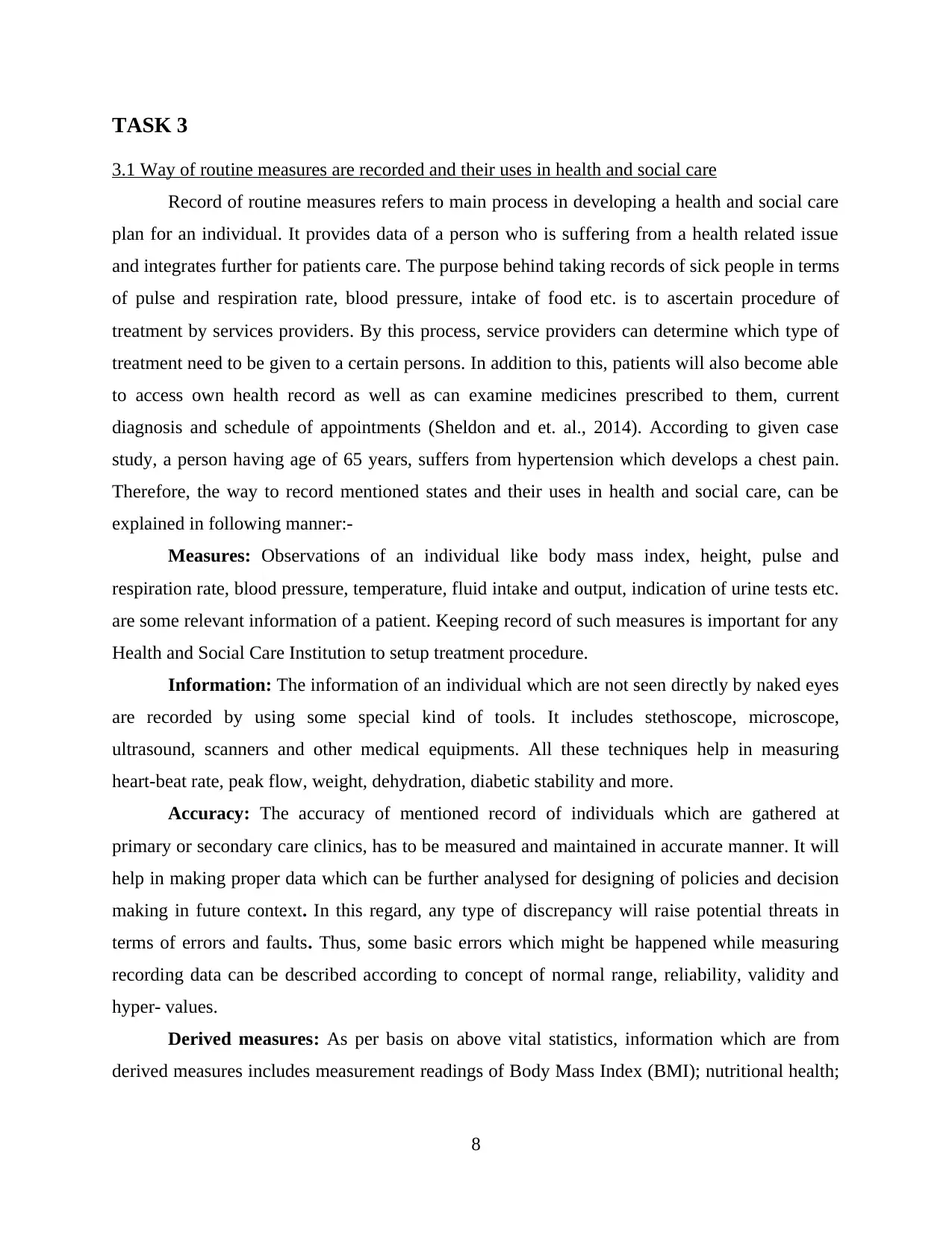
TASK 3
3.1 Way of routine measures are recorded and their uses in health and social care
Record of routine measures refers to main process in developing a health and social care
plan for an individual. It provides data of a person who is suffering from a health related issue
and integrates further for patients care. The purpose behind taking records of sick people in terms
of pulse and respiration rate, blood pressure, intake of food etc. is to ascertain procedure of
treatment by services providers. By this process, service providers can determine which type of
treatment need to be given to a certain persons. In addition to this, patients will also become able
to access own health record as well as can examine medicines prescribed to them, current
diagnosis and schedule of appointments (Sheldon and et. al., 2014). According to given case
study, a person having age of 65 years, suffers from hypertension which develops a chest pain.
Therefore, the way to record mentioned states and their uses in health and social care, can be
explained in following manner:-
Measures: Observations of an individual like body mass index, height, pulse and
respiration rate, blood pressure, temperature, fluid intake and output, indication of urine tests etc.
are some relevant information of a patient. Keeping record of such measures is important for any
Health and Social Care Institution to setup treatment procedure.
Information: The information of an individual which are not seen directly by naked eyes
are recorded by using some special kind of tools. It includes stethoscope, microscope,
ultrasound, scanners and other medical equipments. All these techniques help in measuring
heart-beat rate, peak flow, weight, dehydration, diabetic stability and more.
Accuracy: The accuracy of mentioned record of individuals which are gathered at
primary or secondary care clinics, has to be measured and maintained in accurate manner. It will
help in making proper data which can be further analysed for designing of policies and decision
making in future context. In this regard, any type of discrepancy will raise potential threats in
terms of errors and faults. Thus, some basic errors which might be happened while measuring
recording data can be described according to concept of normal range, reliability, validity and
hyper- values.
Derived measures: As per basis on above vital statistics, information which are from
derived measures includes measurement readings of Body Mass Index (BMI); nutritional health;
8
3.1 Way of routine measures are recorded and their uses in health and social care
Record of routine measures refers to main process in developing a health and social care
plan for an individual. It provides data of a person who is suffering from a health related issue
and integrates further for patients care. The purpose behind taking records of sick people in terms
of pulse and respiration rate, blood pressure, intake of food etc. is to ascertain procedure of
treatment by services providers. By this process, service providers can determine which type of
treatment need to be given to a certain persons. In addition to this, patients will also become able
to access own health record as well as can examine medicines prescribed to them, current
diagnosis and schedule of appointments (Sheldon and et. al., 2014). According to given case
study, a person having age of 65 years, suffers from hypertension which develops a chest pain.
Therefore, the way to record mentioned states and their uses in health and social care, can be
explained in following manner:-
Measures: Observations of an individual like body mass index, height, pulse and
respiration rate, blood pressure, temperature, fluid intake and output, indication of urine tests etc.
are some relevant information of a patient. Keeping record of such measures is important for any
Health and Social Care Institution to setup treatment procedure.
Information: The information of an individual which are not seen directly by naked eyes
are recorded by using some special kind of tools. It includes stethoscope, microscope,
ultrasound, scanners and other medical equipments. All these techniques help in measuring
heart-beat rate, peak flow, weight, dehydration, diabetic stability and more.
Accuracy: The accuracy of mentioned record of individuals which are gathered at
primary or secondary care clinics, has to be measured and maintained in accurate manner. It will
help in making proper data which can be further analysed for designing of policies and decision
making in future context. In this regard, any type of discrepancy will raise potential threats in
terms of errors and faults. Thus, some basic errors which might be happened while measuring
recording data can be described according to concept of normal range, reliability, validity and
hyper- values.
Derived measures: As per basis on above vital statistics, information which are from
derived measures includes measurement readings of Body Mass Index (BMI); nutritional health;
8
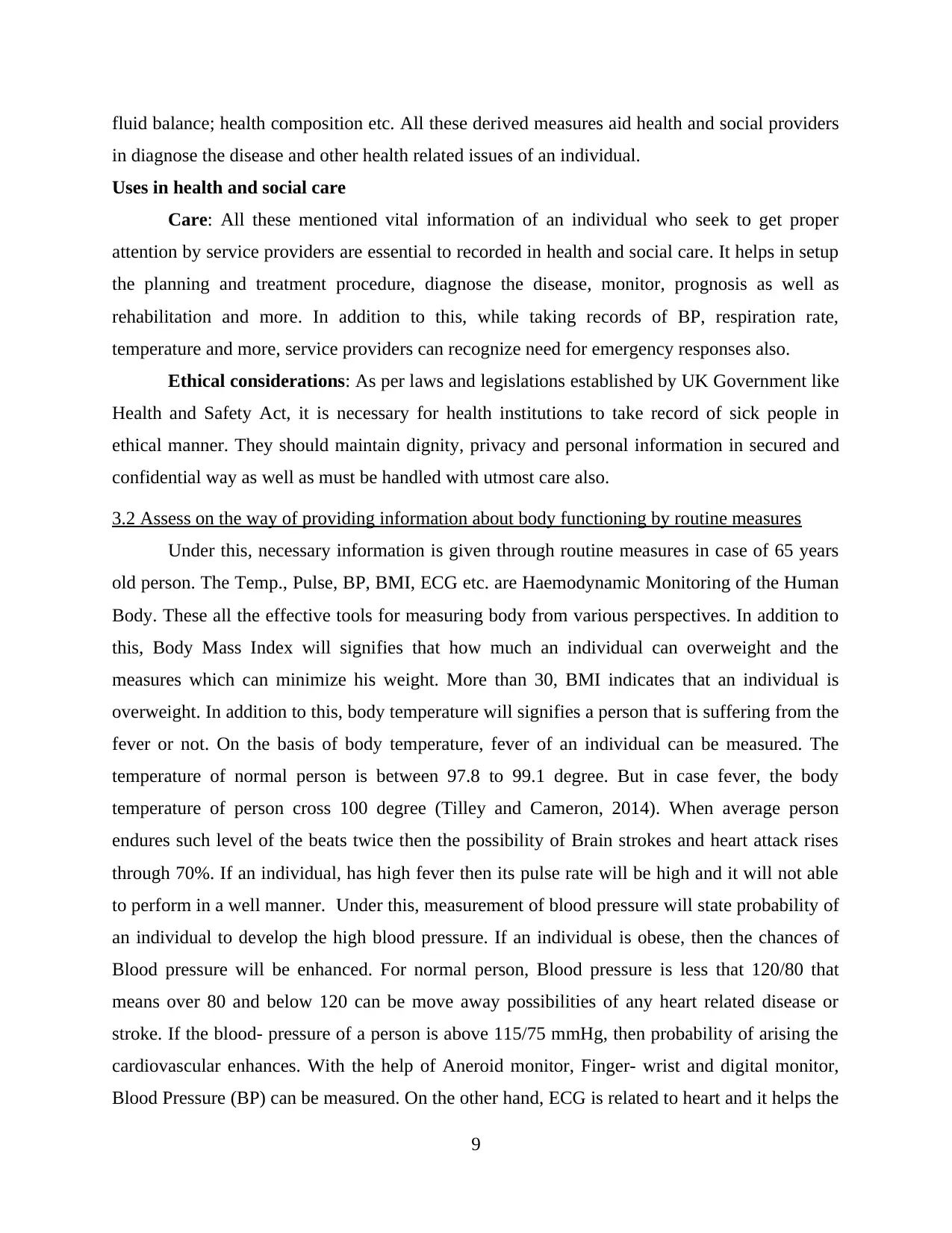
fluid balance; health composition etc. All these derived measures aid health and social providers
in diagnose the disease and other health related issues of an individual.
Uses in health and social care
Care: All these mentioned vital information of an individual who seek to get proper
attention by service providers are essential to recorded in health and social care. It helps in setup
the planning and treatment procedure, diagnose the disease, monitor, prognosis as well as
rehabilitation and more. In addition to this, while taking records of BP, respiration rate,
temperature and more, service providers can recognize need for emergency responses also.
Ethical considerations: As per laws and legislations established by UK Government like
Health and Safety Act, it is necessary for health institutions to take record of sick people in
ethical manner. They should maintain dignity, privacy and personal information in secured and
confidential way as well as must be handled with utmost care also.
3.2 Assess on the way of providing information about body functioning by routine measures
Under this, necessary information is given through routine measures in case of 65 years
old person. The Temp., Pulse, BP, BMI, ECG etc. are Haemodynamic Monitoring of the Human
Body. These all the effective tools for measuring body from various perspectives. In addition to
this, Body Mass Index will signifies that how much an individual can overweight and the
measures which can minimize his weight. More than 30, BMI indicates that an individual is
overweight. In addition to this, body temperature will signifies a person that is suffering from the
fever or not. On the basis of body temperature, fever of an individual can be measured. The
temperature of normal person is between 97.8 to 99.1 degree. But in case fever, the body
temperature of person cross 100 degree (Tilley and Cameron, 2014). When average person
endures such level of the beats twice then the possibility of Brain strokes and heart attack rises
through 70%. If an individual, has high fever then its pulse rate will be high and it will not able
to perform in a well manner. Under this, measurement of blood pressure will state probability of
an individual to develop the high blood pressure. If an individual is obese, then the chances of
Blood pressure will be enhanced. For normal person, Blood pressure is less that 120/80 that
means over 80 and below 120 can be move away possibilities of any heart related disease or
stroke. If the blood- pressure of a person is above 115/75 mmHg, then probability of arising the
cardiovascular enhances. With the help of Aneroid monitor, Finger- wrist and digital monitor,
Blood Pressure (BP) can be measured. On the other hand, ECG is related to heart and it helps the
9
in diagnose the disease and other health related issues of an individual.
Uses in health and social care
Care: All these mentioned vital information of an individual who seek to get proper
attention by service providers are essential to recorded in health and social care. It helps in setup
the planning and treatment procedure, diagnose the disease, monitor, prognosis as well as
rehabilitation and more. In addition to this, while taking records of BP, respiration rate,
temperature and more, service providers can recognize need for emergency responses also.
Ethical considerations: As per laws and legislations established by UK Government like
Health and Safety Act, it is necessary for health institutions to take record of sick people in
ethical manner. They should maintain dignity, privacy and personal information in secured and
confidential way as well as must be handled with utmost care also.
3.2 Assess on the way of providing information about body functioning by routine measures
Under this, necessary information is given through routine measures in case of 65 years
old person. The Temp., Pulse, BP, BMI, ECG etc. are Haemodynamic Monitoring of the Human
Body. These all the effective tools for measuring body from various perspectives. In addition to
this, Body Mass Index will signifies that how much an individual can overweight and the
measures which can minimize his weight. More than 30, BMI indicates that an individual is
overweight. In addition to this, body temperature will signifies a person that is suffering from the
fever or not. On the basis of body temperature, fever of an individual can be measured. The
temperature of normal person is between 97.8 to 99.1 degree. But in case fever, the body
temperature of person cross 100 degree (Tilley and Cameron, 2014). When average person
endures such level of the beats twice then the possibility of Brain strokes and heart attack rises
through 70%. If an individual, has high fever then its pulse rate will be high and it will not able
to perform in a well manner. Under this, measurement of blood pressure will state probability of
an individual to develop the high blood pressure. If an individual is obese, then the chances of
Blood pressure will be enhanced. For normal person, Blood pressure is less that 120/80 that
means over 80 and below 120 can be move away possibilities of any heart related disease or
stroke. If the blood- pressure of a person is above 115/75 mmHg, then probability of arising the
cardiovascular enhances. With the help of Aneroid monitor, Finger- wrist and digital monitor,
Blood Pressure (BP) can be measured. On the other hand, ECG is related to heart and it helps the
9
⊘ This is a preview!⊘
Do you want full access?
Subscribe today to unlock all pages.

Trusted by 1+ million students worldwide
1 out of 18
Related Documents
Your All-in-One AI-Powered Toolkit for Academic Success.
+13062052269
info@desklib.com
Available 24*7 on WhatsApp / Email
![[object Object]](/_next/static/media/star-bottom.7253800d.svg)
Unlock your academic potential
Copyright © 2020–2025 A2Z Services. All Rights Reserved. Developed and managed by ZUCOL.





